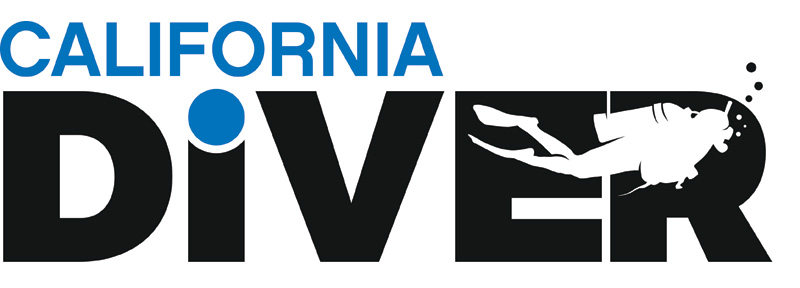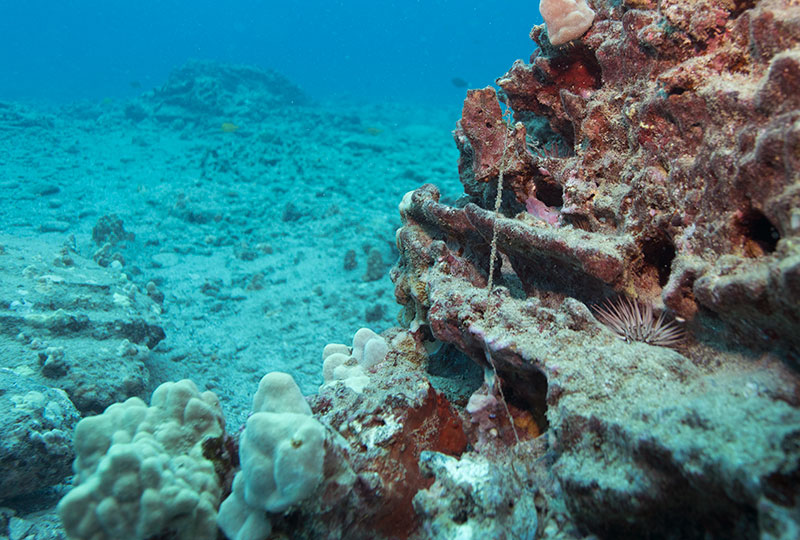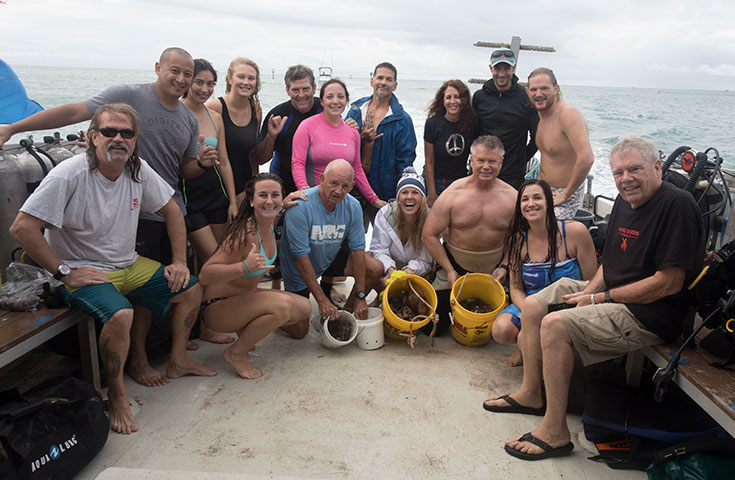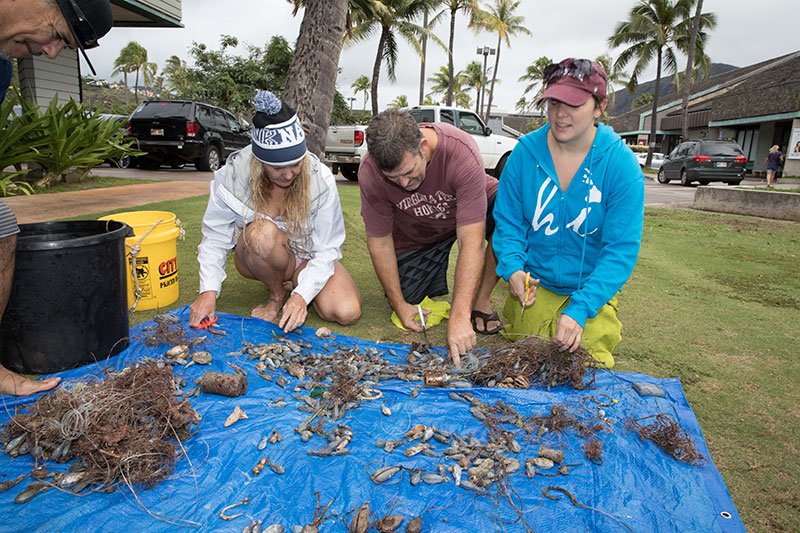Mary Christensen had led a vibrant life loaded with adventure, travel, and perhaps most importantly – a desire to serve others. She’s healed people as a physician, taught hundreds how to scuba dive as a master instructor, and as a passionate believer in ocean conservation, she’s removed thousands of pounds of garbage from the oceans all over the world.
The daughter of a Navy Seal, Mary was naturally drawn to the ocean, and that path has led her to be the general manager of Island Divers on Oahu, Hawaii. It’s there that I had the opportunity to meet her and the staff at Island Divers and tag along with their dive club for one of their ocean cleanup dives.
“We try to do the dive cleanups as often as we possibly can, but it’s strongly dependent on currents, winds, and conditions,” Mary told me. “We’re diving close to the rocks and use lift bags at the end of the dive to lift the trash to the surface, so the conditions need to support that.”
The dive shop she manages also plays a key role in the cleanup. Their dive club members regularly participate (though outside guests are also welcome to join), and the shop allows the use of the boat, sometimes cancelling a paid charter trip to make it happen. “Island Divers donates the use of the boat and our dive club members get to go for free.”For today’s dive, we visited a nearby site called Spitting Caves – about a 20-minute boat ride from the shop. The area is very popular among sightseers, where a quarter-mile long trail edges along the top of rugged sandstone cliffs. The site is also a popular cliff jumping spot (although authorities discourage it for safety reasons), and a popular and well-visited dive destination.
Like dozens of other locations around the island of Oahu, Spitting Caves is also a popular fishing spot. Locals climb down the cliffs everyday, setting up small tents and temporary shelters on the cliff side, and toss their monofilament lines, lead weights, and bait into the waters below. Like most other fishing locations, those same weights, hooks, and lines snag on the abundant corals and rocky outcroppings in the water below, leaving the fisherman with no choice but to break or cut their lines, leaving them to ghost fish on their own for months, and sometimes even years until the hooks rust away.
While fishing hooks eventually do rust away, it’s often after they’ve made a catch. Turtles, eels, sharks, and other curious and hungry sealife are very often spotted with hooks in their mouths and cuts in their bodies from the fishing line. During just one dive today, we found a 3-foot long whitetip shark with a severely torn jaw and a dead moray eel. It’s not an unusual sight – the instructors and divemasters at Island Divers see it on a daily basis.
“Some of the larger sharks and turtles can survive ok with a hook in their arm or lip, but for some of the smaller animals it can be deadly. I saw an eel today that could no longer move because the (fishing) weight kept him stuck in one spot, where he could no longer eat”, Instructor Sarah Moore shared. “It was slowly dying, and unfortunately it’s something we see a lot.”
Mary adds, “We’ve seen turtles that have been hooked through the neck and we often see sharks with a lot of hooks in their mouths. They will rust away eventually, but it’s a long process. We try to cut them off if we possibly can, but they don’t usually let us get that close.”
“We find spark plugs that have been used for fishing weights, which definitely aren’t good for the ocean. People throw cans in, we find t-shirts, hair bands, fishing poles, ladders – it’s just amazing what people will throw away into the ocean,” Mary said. Sarah added that they’ve also found lost drones and GoPro cameras during their dives.
During our pre-dive briefing, Mary reviewed our plan and some instructions on how to remove the debris. It’s a slow, tedious process, she explained, as fishing line and other garbage can actually grow into corals and other life and simply pulling it up can do more harm than good. Every piece of line, every weight, and each individual piece of garbage needs to be carefully removed and lifted from the seabed. Once collected by individual divers on the bottom, they swim with the trash over to larger buckets, which are then lifted to the surface at the end of the dive.
In some cases, Mary recommends that some garbage remain on the seafloor. A bottle, for example, can quickly become a home for an octopus. If debris has been on the bottom long enough, corals may being growing on them. Removing these foundations for life can actually do more harm than good.
Finding fishing gear isn’t hard at all here – I actually spotted the first rock literally covered with line in the first 30 seconds, before I touched bottom. Then the work began, and just as Mary explained, it’s a slow, tedious process.
“Not only is the line seriously tangled up, it’s also wrapped around the corals and in some places it looks like it’s coming straight out of the rock”, one diver shared. “It’s a process of carefully unwrapping the line as best possible, cutting it off, then starting again. It’s so frustrating because there’s so much down there and we can only get a small portion of it.”
Looking around just a few minutes after touching bottom, every diver was focused and busy, and the collection buckets were quickly receiving bundles of line, weights, and other garbage. Fortunately this was a shallow dive (around 30-40 feet deep), so the dive wasn’t limited by our decompression limits. The cleanup lasted about 40 minutes before Mary signaled the end of the dive. Because this is an area with strong currents and since were diving directly at the base of the cliffs above water, it was important to all surface together and swim out to rendezvous with the dive boat.
Back on the boat, I was amazed at how much we had removed from the seafloor during just one dive, but it was quite a typical cleanup dive, I was told. Once returning to shore, the waste was sorted by kind and prepared for reuse, recycling, or delivery to the landfill.
Today, our small team of cleanup divers brought back about 75-80 pounds of lead and at least a few hundred yards of line. After seeing how much was present underwater, it was obvious that the amount recovered was likely a fraction of a percent of the amount that remained on the bottom in the Spitting Caves area. So naturally Mary and the volunteer cleanup team will be going back out again in a few weeks.
“We try and educate as much as we can and go out and show through our actions what we do and recycle as much as we can. I run the cleanup dives quite often and as soon as I get enough interest, we’ll be back out there again”.
– – –
For Mary’s dedication to cleaning up the oceans and organizing cleanup teams in Hawaii and all over the world, Undersea Voyager Project CEO Scott Cassell and Luminox, awarded her the “Eco-Laureate Award” for outstanding contributions to ocean conservation, along with a Luminox Scott Cassell/UVP 3955 dive watch. Upon receiving the watch and award, Mary was quick to point out that it was really her amazing group of club volunteers that deserve the credit as they selflessly donate their time and hard work to the cause.
• • •
If you go:
Island Divers is located just outside Honolulu and also has two other locations on Oahu. They offer all levels of dive training, discover scuba lessons, daily charters, and full rental gear. For more information, please visit their website at oahuscubadiving.com or give them a call at (808) 423-8222.
• • •
Words and photos by Chris Constantine
California Diver Magazine





